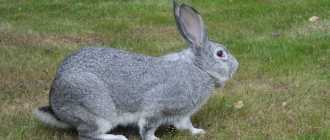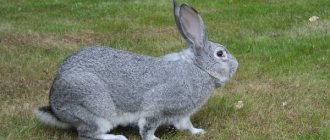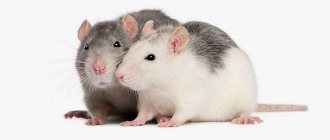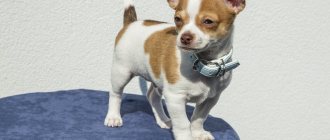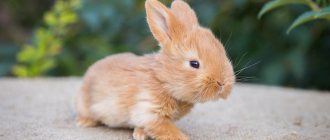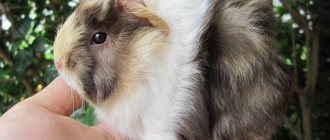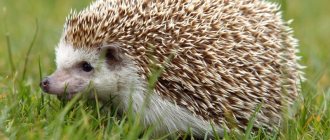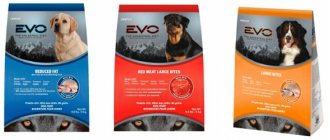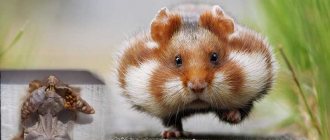Husky is considered one of the most popular breeds in the world.
However, there are many dogs similar to him. Some of them are almost as beloved and popular, others are less known.
Finally, there are breeds similar to the Siberian Husky that few non-specialists have heard anything about.
Why are they all remarkable and can these breeds be considered related to huskies?
Malamute
Representatives of the breed are larger and resemble wolves in appearance. The head is wide, but proportional to the body, the ears are triangular, erect, the eyes are dark, slanted. The coat is two-layered: the guard hair is coarse, and the down is soft, silky. The animal behaves calmly and is friendly towards humans. Attacks of aggression are possible, as a reaction to small animals and a struggle for leadership.
The Malamute is bred in the northern regions for carrying heavy loads. It looks like a husky in color, ear shape, and bushy tail. Characteristic differences:
- larger sizes;
- narrowing of the muzzle towards the nose;
- oval ear tips;
- lack of sharp contrasts in coat color.
How to choose a puppy
The character and individual characteristics of the breed appear at 4 months of age. It is at this time that it is recommended to buy pets.
It is almost impossible to choose the best puppy, as they change as they grow. If the goal is to buy a husky to participate in exhibitions, only experienced dog breeders can help in choosing.
Advantages of buying a Husky puppy and care details:
the baby will easily adapt to the lifestyle of his owners; increased attention to yourself will allow you to better know his inner world; Husky puppies quickly learn the rules of behavior; Babies require increased attention and you need to spend a lot of time playing with them.
If you buy an adult dog, then this moment has its advantages:
- established character;
- trained in rules of conduct;
- surprises in terms of interior damage are excluded.
The cost of puppies depends on how purebred the husky is. Purchasing purposes also influence the price.
- Pet - class is not suitable for participation in exhibitions, but will be a good friend. Such dogs are sold without a pedigree and have some distinctive characteristics from the breed standard. Puppies cost from 20,000 rubles.
- Breed class puppies are sold with good pedigree and fully comply with the standard. The price starts from 30,000 rubles.
- Show class is the most expensive. The starting price for show-class huskies is 50,000 rubles. Puppies have high characteristics, both in appearance and in the achievements of their parents. The sale of such puppies begins at 6 months of age; only during this period can the dog’s compliance with all standards be fully confirmed.
In any case, no matter what class of puppy you buy, he will turn out to be a good friend and companion with whom you are not afraid to go on a trip.
Wolfdog of Saarloos
This breed was developed by crossing a she-wolf and a German shepherd. The dogs are large: they reach 75 cm at the withers and weigh up to 50 kg. From their wolf ancestors they inherited a gray-black color and the inability to bark. In case of danger, Sarlosa begins to howl.
Representatives of this breed are used as guide dogs and participate in search and rescue activities. Distinctive features:
- larger sizes;
- straight long tail;
- representatives of red, brown and pure white colors;
- transportation of light loads over short distances.
How to care?
It was already mentioned above that representatives of this northern breed are undemanding in matters of care. However, this does not mean that you won’t have to look after them at all. Still, the owner will need to take certain actions to ensure that the animal remains clean and healthy. Let's look at how to care for a husky.
The coat of these dogs requires care. It needs to be combed throughout the entire molting period. Wash your dog as needed. Brush the fur periodically to prevent it from becoming tangled or tangled, especially if you have a long-haired cat.
Monitor the condition of your dog's teeth. You need to clean them every day with a special paste. It is advisable to buy special bones and toys for your husky, sold in pet stores. With the help of these things, animals will brush their teeth.
Don't forget to trim your dog's nails. It is advisable to do this at least once a month
Trimmed nails will make the husky safer for both his family and himself.
It is very important to provide eye care for dogs of any age. Wipe your eyes with a damp swab from time to time to remove any discharge that appears.
This should be done as needed. Always examine your dog’s eyes in order to notice the onset of inflammatory processes, which must be dealt with in a timely manner. If you notice redness, green or yellow discharge from the eyes, it is best to contact your veterinarian.
You should also clean your dog's ears. This should be done as needed. Inspect them for injuries and damage, as well as infections and contamination.
Veterinarians strongly recommend against bathing Huskies too often. In most cases, owners wash these dogs only on special occasions. This can happen no more than once a year. These dogs do not need regular haircuts.
Alaskan Klee Kai
Representatives of this breed are short in stature. At the withers they do not exceed 43 cm, adults weigh 11 kg. The second name is mini-husky. The Alaskan Klee Kai comes in only three colors: red, black or gray and white. The coat is long or short depending on the type of breed. Eyes – light blue or dark brown.
See also: How to stop a dog from chewing shoes
Like the Husky, this is an intelligent, active and cheerful animal that gets along well with the breeder. But the Alaskan Klee Kai is characterized by the following external differences:
- short muzzle;
- large ears;
- high-set tail;
- distrustful of strangers.
Chihuahua
The smallest smooth-haired dog breed. The animals were bred in Mexico and named after the largest state of this country, Chihuahua.
The height of the Chihuahua Millie from the Guinness Book of Records is only 9.65 cm.
Smooth-haired Chihuahua.
The breed includes 2 types of dogs: smooth-haired and long-haired. The former have short, soft fur, sometimes slightly elongated on the neck and tail. The standard allows any colors except merle.
Chihuahua puppies mature quickly, so they need early socialization. By the end of 1 year of life, dogs have finally formed habits, behavioral patterns, and character. Chihuahuas easily adapt to new conditions, are not capricious, but are offended by shouts and rudeness. They easily build relationships with pets and are not afraid of large dogs.
Czechoslovakian Wolfdog
This dog breed first appeared in 1999 by crossing a Carpathian wolf and a German shepherd in Czechoslovakia. Externally, the animal appears tall and thin, reaches 65 cm at the withers, and weighs up to 25 kg. Ears – triangular, erect; eyes – brown; the tail is straight, with long hair. The color is from yellow-gray to silver, the coat is short.
Dogs are distinguished by their independent and freedom-loving character, are difficult to train, and are aggressive towards other animals (wolf blood plays a role). External differences:
- drooping tail;
- color with obvious yellowness;
- long ears;
- stretched body.
Nuances of breeding
The crossing of a dog and a wolf in the wild happens quite rarely, and this fact could not but arouse interest among scientists. Most often this happens in areas where the number of wolves is small, and also if she-wolves are left without a mate. In other cases, wild animals pose a danger even to large dogs.
If we are talking about breeds that simply look like wolves, their breeding does not differ in any particular way. As for crossing, certain difficulties may arise here. Due to genetic displacement, it is not uncommon for only 1-2 puppies from a litter to be considered a successful crossbreed. Congenital anomalies of physical development occur, for example, when the skeleton and ligament system are inherited from different parents.
Another problem with such crossbreeds is the bite. Its fault, as in the previous case, is the difference between the types of parents. Pathologies may be incompatible with life, then the puppies are simply euthanized. In cases where the indicators are within normal limits, and the character and instincts do not inspire fear in researchers, the animal is provided with the necessary conditions of detention.
One cannot ignore the problem that arises when breeding crosses between a dog and a wolf, such as mental imbalance. The pack instinct is very pronounced, as a result of which the animal will fight for its place more actively than an ordinary dog and can use various, sometimes even harsh, methods for this.
When puppies appear that meet the requirements of breeders, you need to remember about their mandatory, as early as possible socialization. Literally in the first minutes of life they must get to know a person. Experts also recommend not depriving children of the company of puppies of ordinary dog breeds. Socialization is a long process and must be maintained throughout the animal’s life. However, wolf genes still will not allow making a mestizo absolutely soft and good-natured.
See the following video about the characteristics of the breed.
Samoyed husky
This is a descendant of the white wolf, domesticated in Southern Siberia. Outwardly, it is a white, fluffy, medium-sized dog that looks very aesthetically pleasing. Ears – triangular in shape, erect; wool – fluffy and thick; color – snow-white; the tail is in a “ring” when moving and lowered when the dog is at rest.
Like the husky, the Samoyed is active, playful, friendly, strong, and resilient. It has an independent and stubborn character and requires strict training. External differences:
- plain color;
- limbs, body shorter;
- dense, long wool;
- erect but short ears.
Character and behavior
Russian Laika puppies are naturally willful, proud and independent. Such a companion is suitable for a person who is very confident in his abilities.
The Russian-European breed is famous for its qualities:
- fearlessness;
- assertiveness;
- balanced character;
- high level of ability to work;
- the ability to make quick decisions while hunting;
- speed of reaction.
If you do not train Russian-European Laikas, or do it incorrectly, then the character of the “Russian” dog greatly deteriorates, which manifests itself:
- in causeless barking;
- frequent escapes;
- difficulties in training.
Dogs, due to their well-expressed and competently cultivated hunting qualities, will not miss any living creature running past, which can result in chasing a cat, dog, etc.
All this, in addition to good care and proper diet, will become a solid foundation for mutual understanding between the owner and the puppy. Laikas are neutral towards the rest of the family.
Expert opinion
Leonid Rodin
Experienced dog breeder
Ask a Question
The Russian-European Laika has only one drawback - it trusts people too much. For these dogs, a person is always a friend. Although, unlike service or decorative breeds, she does not look into the eyes and does not catch every movement. The Russian-European Laika is best suited for living outdoors. Even long walks in city parks cannot satisfy her passion for movement and searching for game. For them, it is considered normal to go for a walk for a day or two, and then - as if nothing had happened - to show up home. Another ineradicable trait is complete independence. The dog easily adapts to the wild, happily eats berries and drinks from puddles. Entire generations of living in comfortable apartments cannot erase this habit from her. It is noteworthy that even huskies who grew up in the “urban jungle” in the forest immediately shed their civilizational habits and become similar to their distant ancestors. They hunt everything that moves. Therefore, getting a Russian-European Laika for home keeping is a bad decision. She will always be attracted by hunting - the only activity in which this dog has no equal.
Breed and children
Laika can keep old people and very young children company, since dogs are completely safe due to the absence of the aggression gene.
But they will not be comfortable with each other: huskies are very active and capricious; with little older family members who are particularly active and playful, the dog will feel great and will become not only a cheerful and mischievous friend, ready for any entertainment, but also a reliable one. defender.
Tamaskan dog
This breed was developed in Finland by crossing a German Shepherd with a Siberian Husky and an Alaskan Malamute. At the withers it reaches 75 cm, an adult weighs up to 45 kg. There are representatives of the breed of gray and black-gray color, mostly short-haired.
Dogs are hardy, strong, cheerful, good-natured, and become a full-fledged member of the family. Like huskies, they carry heavy loads and perform difficult long-distance races. External differences:
- long ears;
- external resemblance to a wolf;
- sweeping body;
- small head.
See also: Dog toys at home
Common Animal Traits
Dogs, which are very similar to wolves, share common features with these animals. First of all, we are talking about appearance. However, other features may also appear. When it comes to hybrids, it must be taken into account that they need the earliest possible socialization and education.
Such dogs, like their wild relatives, are prone to barking and howling. They cannot stand loneliness. At home, these animals, yearning for their owner, can cause significant damage to property, ruin furniture, clothes and shoes.
Both species of these animals molt 2 times a year. If you keep your dog at home, this factor can be very unpleasant. To minimize the consequences, the dog should be brushed regularly and the rooms should be cleaned. However, the best option would be to keep it outside, where the dog will feel especially comfortable.
Northern Inuit
The breeding of this breed involves the German Shepherd, Alaskan Malamute, Siberian Husky and other sled dogs. At the withers the animal reaches 76 cm and weighs from 25 to 50 kg. The wedge-shaped head with an elongated muzzle is proportional to the body. Ears – slightly rounded, but erect; eyes - from light blue to brown; tail - lowered down, in the shape of a sickle. Color – white, black or gray.
The nature of the northern Inuit is freedom-loving and stubborn, but calm. Unlike huskies, representatives of the breed do not trust strangers. External differences:
- square body format;
- slight pubescence on the tail;
- pronounced collar on the neck;
- deep, wide chest.
Larger breeds
Greenland dog
It is distinguished by an excellent sense of smell, strength, endurance, stamina, unpretentiousness and the ability to navigate the terrain well.
The head is similar in shape and size to a wolf: the skull is wide and slightly convex, the muzzle is short and moderately wide, slightly tapering towards the nose. The ears are triangular, small in size, erect. The eyes are dark, slightly slanted.
The body is strong and muscular, the neck is quite short and powerful, the chest is wide and voluminous. Limbs are strong, parallel and straight. The tail is thick and fluffy, relatively short, usually carried over the back.
The wool is two-layered, very thick and harsh. Any color of a Greenland dog is acceptable, except for albinism.
IMPORTANT!
Outwardly, these dogs are similar to huskies, but they are larger and stockier - their height should be at least 60 cm for males and 55 cm for females.
By nature, Greenland dogs are quite temperamental and friendly towards people, although they can be overly self-sufficient and independent. They do not recognize every person as an owner, but only the one who can achieve their respect.
Akita Inu
A large, Spitz-like dog used as a hunting and guard dog. The height at the withers is from 61 to 67 cm, and the weight is 40-50 kg.
This is a strong and robust animal with a harmonious physique. The head is quite large and heavy, but at the same time proportional to the body, the transition to a short muzzle is well defined. The eyes are small and triangular. The ears are medium-sized, erect and very dense. The body is muscular and strong, slightly stretched in length.
The Akita Inu coat . It consists of elongated and rather coarse hairs of the top layer, a hard but somewhat shorter awn and a soft dense undercoat. The most common colors are red, brindle, sesame or pure white.
Akita Inu is devoted to its owner and, if properly raised, is not aggressive. It is believed that her character contains feline traits, such as some detachment, as well as the habit of washing herself with her paws.
They are similar to huskies not only in appearance: both of these dogs are quite independent and independent, in addition, they both have hunting instincts.
American Akita
The American Akita is a fairly large dog (61-71 cm at the withers), with strong and even heavy bones, a massive head and a moderately wide muzzle. The ears are small, erect, the eyes are medium-sized, dark brown.
The body format is slightly stretched, the chest is voluminous and powerful, the back is straight, the limbs are parallel and strong. The tail is fluffy, usually curled into a complete or incomplete ring.
The coat is double, consisting of a soft and relatively short undercoat, as well as a thick and harsh elongated awn. Oh beauty can be anything.
The character is balanced and calm. These are friendly, but at the same time careful and vigilant dogs.
NOTE!
American Akitas resemble Siberian Huskies not only with erect triangular ears and a wedge-shaped head, but also with endurance, unpretentiousness and independent disposition.
Utonogan
These dogs are especially similar to huskies, with only a yellowish tint to their coat. Obtained by crossing an Alaskan Malamute, a German Shepherd, and a Siberian Husky. An adult animal weighs from 25 to 50 kg, reaches 60-75 cm at the withers. The color combines white, gray, brown and even black.
The dogs are kind, hardy, can live in a country house or apartment, and need long games. External differences:
- unusual color;
- wide ears;
- hanging tail with long hair;
- elongated muzzle.
All these breeds of sled dogs closely or vaguely resemble the Siberian Husky and are its descendants. All animals are hardy, but stubborn and capricious, and require rigor and strict training.
How to choose a puppy
The breed is common and purchasing a puppy will not be difficult. This can be done in an official nursery or from a private person; the second option does not guarantee the health, purebred and adequacy of the pet. A good breeder will provide the necessary package of documents, tell you about the breed line, the advantages and disadvantages of the parents, and their diseases. He will help you decide on the choice of a puppy and give recommendations on care and maintenance.
Before buying a dog, you need to choose the gender of your future pet. As a rule, bitches are more docile, calmer, and can bear offspring. Males are stronger, more resilient, but too energetic
It is also worth paying attention to the class of the puppy, it not only determines the cost of the animal, but also its future career
There are three classes of dogs:
- Pet class - the cheapest dogs that have all the necessary documents, but have minor flaws that do not prevent them from being pets;
- Breeding class – puppies with ideal external parameters, fully comply with standards, suitable for breeding;
- Show class - the offspring of champions, prize-winners of exhibitions, with ideal external parameters, their career is exhibition.
Husky puppies look like cute bear cubs. They will be playful and curious. Healthy pets always look neat and have no obvious defects or deviations from the standard. The cost of a dog directly depends on its class. So, a pet without a pedigree can be purchased for 7-10 thousand rubles, but a show-class puppy will cost 70-120 thousand rubles.
Huskies will make good pets, stately, beautiful and positive. They will fill the emptiness in the house with their cheerful disposition. But caring for the puppy will fall on the shoulders of all household members, so the decision must be made jointly.
Aries - Alabai
A true comrade in arms: he won’t let the enemy near, and will hide behind his partner’s back only to suddenly jump out at the right moment and bite everyone. A dog full of strength, courage and self-esteem. And truly asinine stubbornness: if an alabai decides something, then so be it. Those who want to argue must first move seventy kilograms of Alabai flesh, from the tip of the fang to the tip of the tail, created specifically to crush ferocious wolves. So you're saying there are no takers? Hm. Alabai thought so. The Aries young lady too.
External features
Before purchasing a puppy, you should look at the entire litter. This is the easiest way to find out the character of each child, his inclinations and potential.
Active doggies will:
- play with others;
- try to get out of the enclosure;
- show increased interest in the world around you.
They happily meet strangers and are not at all afraid of them. Once in your arms, such a puppy will begin to sniff you, try to lick you, etc. You just have to remember that you should not take the animal without the breeder’s permission.
During the inspection, it will be necessary to pay attention, first of all, to the following. The eyes of a regular husky are almond-shaped and medium in size.
The eyes of a regular husky are almond-shaped and medium in size.
A slight slant does not contradict the standard. They come in different colors:
- brown;
- blue;
- heterochromic (multi-colored).
However, many people believe that only huskies with blue eyes are purebred. However, this is a false statement.
A husky puppy's ears should be triangular and set high. Their tips are slightly rounded and point clearly upward. A good dog's head is proportional to its body. The skull tapers noticeably from the cheekbones to the eyes. The back is straight, of medium length. The chest is not too wide, but not narrow either. The lips are dark and tightly pressed.
It is best to choose a dog when it is already 2 months old. It is at this age that her proportions fully correspond to adults. A little later, harmony is temporarily lost - the puppies become awkward and overly long-legged. It is also worth understanding that sometimes boys lag slightly behind girls in development.
In order not to make a mistake when purchasing, it would be advisable to visit several nurseries that breed huskies. You should never rush into a purchase, because a dog will last a long time.
Why do people choose mixed breeds as pets?
There are several main reasons why dog lovers buy mixed-bred huskies:
- Breed mixes are cheaper. This is where a person’s inherent desire to save money on buying a puppy comes into play.
- It is a misconception that half-breeds are easier to care for, while purebred dogs are difficult to maintain.
- The belief that the husky mix is more fully consistent with the tasks assigned to a pet (protection, assistance in hunting).
- The desire to have an exotic (not like everyone else) pet. As a result of mixed crossings, puppies with an original exterior are obtained.
- Mixed-breed puppies are less sensitive to genetic pathologies that are inherent in their purebred parents. Mixed offspring are considered healthier.
Similarities
Despite the fact that there are many distinctive features, they still have many more similar features. Each dog breed has a certain value.
So, both breeds are intended for transporting people in cold conditions. Their fur is quite thick, thanks to which they can easily withstand severe frosts. Their coloring is almost identical. In addition, their height is almost the same, Malamutes are only a few centimeters taller.
If you compare Huskies with Mini Klee Kais, they are too similar in appearance, with only a slight difference in height. In addition, the character of small pets is more friendly and domesticated. They can even guard the house. Huskies are only capable of playing with people, and are completely unsuitable for protecting private property.
Age of change
The beginning of the twentieth century was a turning point in the history of the breed. Soviet dog handlers decided that this dog was too small for cargo transportation, and therefore useless. She lost her breed status and breeding was prohibited. A new round of development of the breed occurred thanks to the Americans. Around 1930, the Alaska Gold Rush began and several teams of huskies were taken there. It was here that sled dogs showed themselves in all their glory. The path to the mines was not close, but with such partners it became much more fun.
Huskies began to rapidly gain popularity and participate in a variety of exhibitions and competitions. Around this time, representatives of the glorious breed even became national heroes, fighting their way through a snowstorm with a load of medicine for the city. The Husky dogs shone again. Photos of hero dogs were seen by the whole world.
Human interaction
For humans, dogs today are real pets, protectors and helpers. They are distinguished by friendliness, obedience and a number of other individual qualities that distinguish different individuals and representatives of different breeds from each other. They cannot stand prolonged loneliness and are very bored when their owners are away from home for a long time.
But this cannot be said about their wild relatives, who love solitude and do not need constant communication. In addition, they are characterized by increased aggressiveness. For example, the latter, in severe hunger, can attack an animal or person without hesitation, while domestic animals are in no hurry to get involved in a fight with a predator, with the exception of protecting themselves or their owner.
At the same time, research confirms that dogs are able to understand humans much better than their predatory counterparts. To prove this, scientists conducted an experiment: they placed 2 closed containers with meat in front of wolf cubs and puppies and told them with facial expressions and gestures where exactly the treat was hidden. As a result, the puppies, compared to wolf cubs, understood clues and found food faster.
For wolves, which are accustomed to wild habitats, rapport with humans is not an important skill. At the genetic level, they perceive each other as a source of danger, since their meetings in most cases do not bode well for either one or the other. For example, in the forest a person usually acts as a hunter who needs a trophy, not new friends.
Amazing video about the friendship between a man and a she-wolf:
The wolf (canis lupus), also called the gray wolf or common wolf, is a predatory mammal belonging to the canidae family. The wolf belongs to the wolf genus, which also includes the coyote and jackal. In the canine family, the wolf is the largest animal.
Here are its dimensions: the length of the wolf is up to 150 cm, including the tail - 2 m, height at the withers - 90 cm, body weight - the same as the weight of an adult, maybe up to 90 kg.
According to recent studies of wolf DNA, it has been established that the wolf is the ancestor of the dog. Probably a long time ago, wolves were domesticated and a breed of domestic wolf - a dog - was developed.
The wolf was previously distributed quite widely throughout the world, especially in Eurasia and America. Currently, as a result of the mass extermination of the wolf, and due to the spread of cities and villages, the wolf's habitat has sharply decreased.
Moreover, in some regions this predator is now not found at all. In other regions it appears less and less often, because there are areas in which hunting it is still not prohibited. It continues to be exterminated, since this predator still kills livestock, can attack humans, and besides, hunting a wolf is an old human pastime.
However, the wolf brings great benefits - it regulates the balance of the ecosystem, for example, in the taiga, in the steppes and mountains, in the tundra, the wolf helps nature get rid of dying or sick animals, thereby healing the gene pool of nature.
There are 32 subspecies of wolves in the world. In Russia you can find common and tundra wolves.
Proper training
These dogs are energetic, inquisitive, playful, stubborn and cunning. Therefore, puppies need training. They are able to remember a huge number of commands and carry them out, provided they are properly trained. In this regard, it is better to seek help from specialists, since it is difficult to train these animals due to their restlessness and playfulness. Therefore, education often ends with the dog training the owner, and not vice versa.
If you decide to train your pet yourself, then you need to do it in a playful way, directing his energy in the right direction, show a lot of patience, and under no circumstances raise your voice at him or be rude to the animal. Praise him often and reward him with something tasty. And the dog quickly learns everything. If the puppy is well brought up, this will help the owners get satisfaction from communicating with him.
The Klee Kai is a willful dog, it is capable of making its own decisions without waiting for the owner’s commands. For this reason, it is necessary to train your puppy on a leash from a young age when walking. These dogs are very affectionate and loyal to their owners, but are suspicious of strangers. They get along easily with other pets in the house, but are intolerant of strangers.
Origin story
The Siberian Husky has been living with humans for several centuries. Bred in cold climatic conditions in the Far North. Local residents needed a dog that could easily cover long distances and transport people and cargo. The formation of the husky's character was greatly influenced by regional climate conditions with fairly low temperatures. Under their influence, the structure of the animal was formed.
Since the 20th century, there has been an active spread of the breed throughout the world. Residents of the American continent appreciated such qualities of their four-legged friend as agility and the ability to walk smoothly in a harness.
Alaskan mushers needed dogs for sled dog racing. The legendary husky Togo, in the team of Leonard Seppala, did not give up the championship for many years in a row. However, he gained fame for completely different merits.
In 1925, a dog relay race was held, during which Leonard Seppala's team, led by Togo, covered a long section of the route and reached a small town in Alaska. The inhabitants of Nome were exposed to a fatal disease, and the dog Togo, with other dogs in the sled, delivered them anti-diphtheria serum. Thanks to him, residents received a chance for recovery.
At that time, getting to the small town was completely problematic, since natural conditions did not allow it. The leader of the pack with his faithful dogs covered 146 km of the road, 80 km of which they walked on the ice of Norton Bay in severe frost conditions of -400, with a strong snowstorm. Togo's endurance, courage, and instincts helped the team reach the town of Noma and help people.
Since huskies were sled dogs, their further selection was carried out in America; in our country, sled dogs were considered unpromising.
In the USA, as a result of crossing aboriginal sled dogs with huskies, mixed breed pets appeared that outperformed huskies in racing competitions. However, the developed dog breed was not recognized by international organizations, since the varieties were of different types.
In the 70s, the breed was presented at exhibitions. L.Demidoff and E.Sili convinced people that a bright dog with blue eyes is suitable for keeping in an apartment, as it is a companion dog.
In the 90s, the husky returned to Russia, its historical homeland. In 1995, the first dogs were brought from the Czech Republic and Belgium. By 2000, the number of husky puppies increased to 150 individuals.
Aquarius - Jack Russell Terrier
If a Jack Russell catches you red-handed (you are reading the newspaper here when the dog has not been playing for five minutes!), you will not be able to get away. You'll have to throw the ball again - and throw the ball again. Ball. Ball. Ball. Ball. There is, of course, another option - you can abandon the Jack Russell, in the sense of being left to the mercy of fate: let him entertain himself, since he is such a funny fellow! But it should be remembered that the Jack Russell Terrier is not just a merry fellow, but a hunting dog, ready to dive into a hole with anyone and take a fight there. So if your Jack Russell begins to entertain itself, there is a chance that you will not be very happy with the result. I mean, you'll be tortured to hide the corpses. So you better throw him the ball. And go to the skating rink with Aquarius. Otherwise it will be worse.
Popular
- Blue lipstick for Sagittarius, and contouring for Aries: beauty trend for the zodiac sign
Upbringing
If you don't have much time, a Husky puppy will bring a lot of problems. He needs to be dealt with almost constantly, because if left alone, he will begin to gnaw, dig and destroy everything around him. You need to remember about upbringing from day one. A husky can have only one owner, to whom he will obey. The dog will love and recognize all other family members, but there can only be one leader. This is a very active and mobile dog, so before starting any activity, you need to give your pet plenty of time to run around for at least an hour, or even better, come up with a game together.
Under no circumstances should you abuse the good nature of this dog. You can’t shout at her, much less hit her, otherwise, instead of a royal wolf, you will grow up a hunched creature with a sad look. For the training process to go well, you first need to choose a name for the puppy. Nicknames for the Husky dog breed should match it, beautiful and bright. For a male dog, the nicknames Cupid, Buran, Silver, Thor are good. For a female dog, you can choose a more gentle and beautiful name: Runa, Aurora, Laska, Tessa.
Why do huskies end up in shelters?
By visiting any of the sites that offer shelter dogs, you can see how common huskies are found there.
Most of them ended up in the shelter for a completely banal reason - they ran away from their owners. Some huskies manage to find new owners only in private homes, since “runaways” have an uncontrollable and freedom-loving disposition - walls, doors and furniture are not barriers for huskies. On their way they destroy everything.
There is a known case when it was necessary to take a photo of a one-year-old husky for an advertisement. The young dog tried to get out of the collar and wanted to run away, despite the good attitude of the owners. I had to pull the leash tight and secure the dog so that he wouldn’t move for at least a couple of seconds. This is a small example of the wild, freedom-loving and rebellious spirit of the husky, which is to the taste of few.
And although breeders are aware of the complex nature of huskies, they still “disappoint” their owners and end up in shelters. Looks like fashion is to blame.
We also recommend reading:
I would never have thought that I would have a dog, because I am a cat lover, a poultry farmer, a fish farmer and a rat breeder (true story) 10 puppies is not the limit! Chihuahua Lol was included in the Guinness Book of Records Top 10 strongest jaws on the planet Vasya: an unusual cat who came into the family on his own (a real story from a reader)
